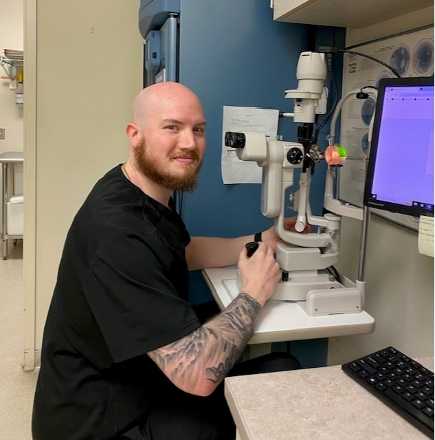Eye Bank Processing Supervisor Gets More Than Expected from the Job
Rocky Mountain Lions Eye Bank (RMLEB) provides opportunities for growth while employees find satisfaction in fulfilling the organization’s mission.
By Rae Price - May 28, 2025
Working for an eye bank was not something Kyle Nance had in mind after finishing college with degrees in biology and psychology; in fact, he wasn’t even aware such a job existed. Now, seven and a half years later, Kyle is a distribution and processing supervisor for Rocky Mountain Lions Eye Bank (RMLEB).
After undergraduate school in Illinois, Kyle wanted to become a physical therapist, but his application was wait-listed. While waiting, his college roommate (who was from Colorado and familiar with RMLEB) told him about the organization. Kyle saw an opening for an eye tissue recovery technician, applied, and soon after started working for RMLEB where he has continued to learn and grow with the organization.
Opportunities to Advance at Eye Bank.
RMLEB offers many opportunities for advancement and Kyle has moved up when he could, saying, “I was intrigued about what we did and wanted to learn more about it.” With eagerness to learn, he jumped on every chance there was to advance or learn something different.
In addition to his role as supervisor, Kyle is also one of the trained technicians in Descemet’s membrane endothelial keratoplasty (DMEK) and Descemet’s stripping automated endothelial keratoplasty (DSAEK) at RMLEB. DMEK and DSAEK are procedures used to prepare tissue for each surgeon’s exact specifications before it is shipped. This may involve separating the layers of the cornea when a full thickness graft is not required.
While he is not a doctor, Kyle explained there are several types of cornea surgeries, each specific to the diagnosis of the patient and the preference of the surgeon. A penetrating keratopathy (PK) procedure involves a full thickness transplant, which surgeons will use if there is a perforation or an ulcer that is growing or something that affects most of the cornea. This surgery, Kyle explained, is more invasive and requires multiple sutures and a longer recovery time.
He went on to describe cornea transplants using individual layers of the tissue: that’s where DMEK and DSAEK come in. In this procedure, he said surgeons are just transplanting the bottom layers of the cornea. The top half of the cornea may be fine in the patient, but they have a disease or dystrophy on the endothelium, which is the bottom layer of the cornea. “They can just transplant that single layer, which requires less recovery time and has good outcomes,” Kyle said.
When RMLEB processing technicians prepare eye tissue for surgeons, it helps ensure the tissue is ready for the patient when they are in the operating room. “Once the surgeon is in the operating room with the patient, if something goes wrong [when prepping the cornea] it can cause delays. Processing the tissue at the eye bank ahead of time is a safe way where we can evaluate the eye tissue before and after we process it, to make sure the recipient gets the best possible outcome,” said Kyle.
The cornea is made of five layers, so the work to separate those layers requires a steady hand. Kyle explained, “For DSAEK we are using a blade to section the cornea and we are sectioning anywhere from a thickness of 120 microns down to 50 microns. For DMEK, we are manually peeling away just the Descemet’s Membrane and the endothelium which is about 10 microns thick. So, it’s a very small, delicate tissue.”
For comparison, a human hair is about 150 microns thick.
Kyle’s role also involves matching available eye tissue with patients. He said it is like fitting a puzzle together and requires a lot of critical thinking. He and his team are always aware of the available eye tissues from recently deceased donors while monitoring surgeon requests. After corneas are recovered from deceased donors and evaluated for quality, putting the puzzle together begins. Kyle said they need to look at surgeons’ specific eye tissue requests, surgery dates and locations as preparation and shipping need to be considered in the overall logistics; with that in mind, the majority of eye tissue from RMLEB is placed within 3-5 days of recovery.
Kyle and his team carefully consider each surgery group’s requests to make sure they aren’t missing any opportunities to use the donated eye tissues. One of the challenges is trying to plan around the unpredictable nature of the business, not knowing how many surgeons will need tissue, and obviously, not knowing how many eye tissues will be available. “We have to make sure we are being as efficient as possible to make sure we are placing every possible cornea and giving it the best possible outcome. The unpredictability of everything and reacting to what we are given can be challenging.”
While Kyle would encourage others with an interest in a career with eye tissue donation to explore options with RMLEB, he noted that it is important to find ways to remain grounded, saying, “There are emotional situations that you need to overcome, especially when dealing with grieving families.” He advises new employees to try not to take things personally when talking to families, keeping in mind the flood of emotions they may be experiencing.
There is also pressure of working within the strict timeframes of eye tissue recovery and placement, but Kyle explained as employees become more familiar with their duties it becomes rewarding and less overwhelming. He would encourage new employees to give themselves time to acclimate and learn before thinking the job isn’t for them.
Kyle calls himself a very “Zen” person and keeps grounded outside of work with interests in outdoor activities that Colorado offers, including hiking and attending sporting events.
Fulfilling wishes of eye tissue donors is rewarding.
The processing and distribution team at RMLEB is the last touch before the eye tissue is sent to surgeons, a point Kyle takes seriously, knowing the impact providing quality tissue will have on the cornea transplant recipient.
He said the job can be fulfilling, “I think, just working in eye banking in general is great in that we get to help fulfill a donor’s last wish upon death, and in doing so we are helping someone else gain the gift of sight. We’re really helping two different parties.” Kyle continued, “I think it is really rewarding knowing that at the end of the day we are doing our best to make sure that every donor gets the best care in fulfilling their wish while helping recipients and get a positive outcome.”
RMLEB helps facilitate letter writing between donor families and recipients and often shares these letters with staff. Kyle likes hearing the letters, saying, “It’s a great way to bring everyone back and be reminded of why the eye bank exists. This can be a very intense, fast-paced environment where you can get lost in the weeds; it’s good to have reminders like this of why our work is important.”
Kyle would definitely encourage others to say “Yes” to eye, organ and tissue donation, “I would sign up twice if I could, because of seeing the outcomes that people have from lifesaving and life-improving [eye] tissue donation; there is no downside to it.”
